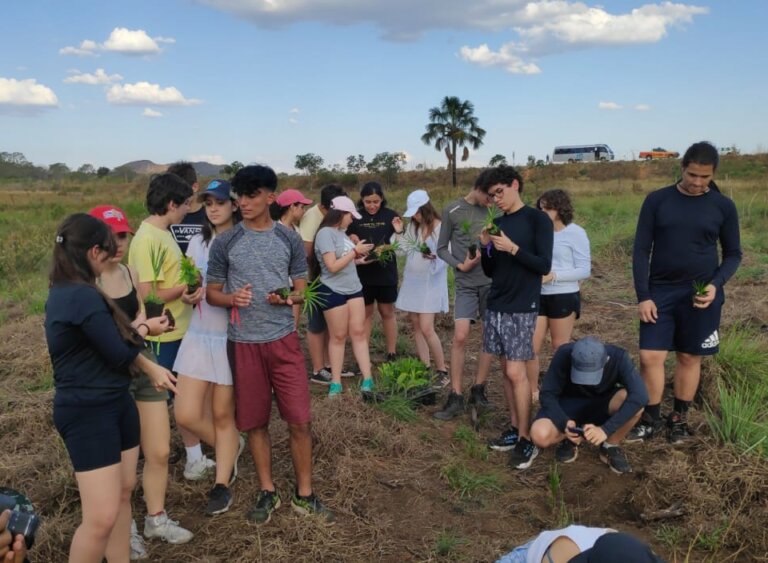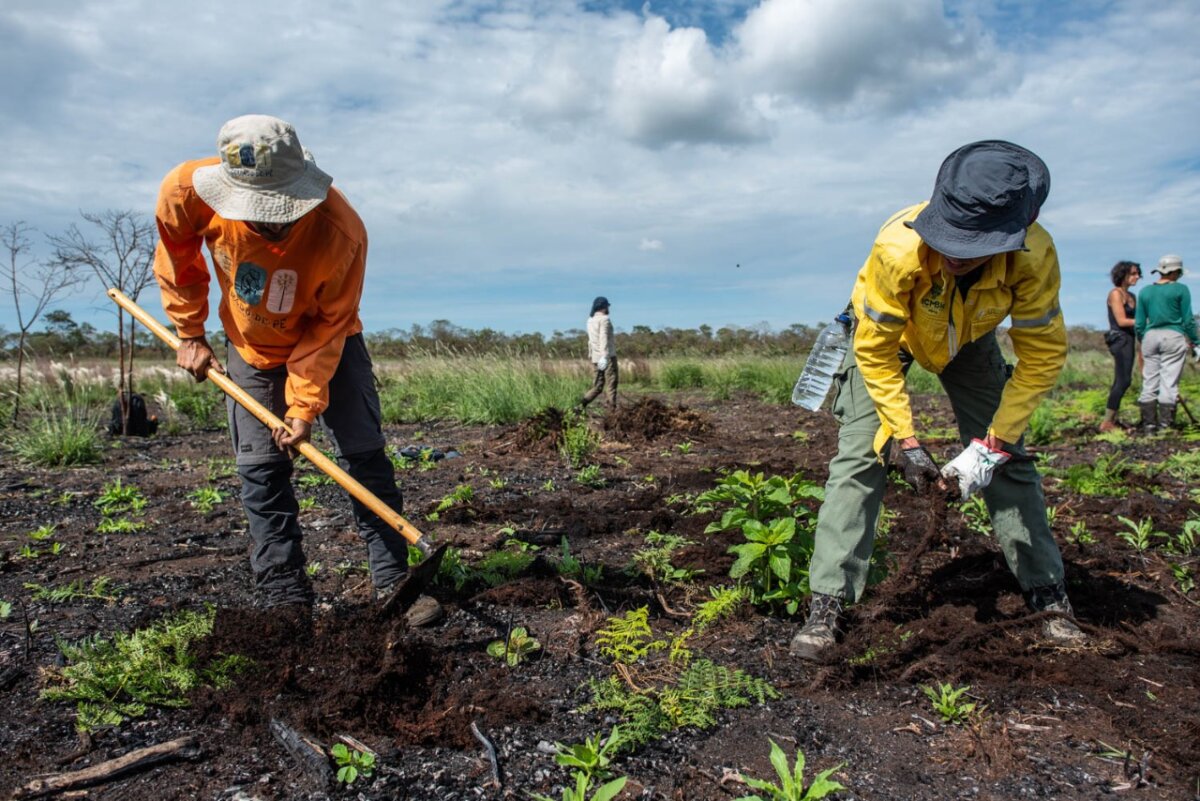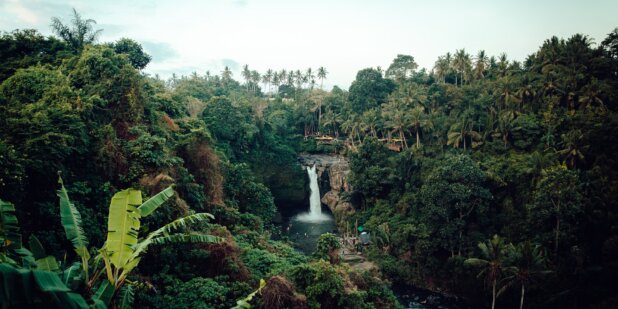- About
- Topics
- Story
- In-Depth
- Picks
- Opinion
- News
- Donate
- Signup for our newsletterOur Editors' Best Picks.Send
Read, Debate: Engage.
Covering a quarter of Brazil's landmass, the Cerrado is vital for its environmental services. While deforestation threats persist, community-based solutions offer hope for people and nature.

© Associação Cerrado de Pé.
'The heart of Brazil.' This is how the Cerrado, the second largest biome in Brazil and Latin America, is dubbed by the Institute for Society, Population and Nature (ISPN, in the Portuguese acronym), dedicated to finding environmental solutions for the Cerrado. Situated in the central region of Brazil, the Cerrado spans over 2 million square kilometers, making up approximately a quarter of the country's total land area.
Resembling a savannah, the Cerrado is characterised by low to medium-sized twisted trees. However, it hosts a diverse range of biodiversity along its borders with the Amazon, Pantanal and Atlantic Forest. The WWF states that this biome is home to over 330,000 plant and animal species. Also known as the "Brazilian water tank," the Cerrado contains numerous springs and plays a crucial role in recharging water resources in major river basins of Brazil and South America.
"Its location, in the heart of Brazil, is a good metaphor for the importance of the biome for the national territory and neighbouring countries," states ISPN, which backs seven projects in this region. These projects focus on maintaining ecological balance, fostering sustainable practices and respecting the knowledge of traditional peoples, communities and family farmers.
The Cerrado is home to approximately 20 million people, including indigenous communities and traditional quilombolas with roots in formerly enslaved populations.

© Associação Cerrado de Pé.
But this vital region now faces imminent threats from deforestation and increasing land usage, primarily driven by agribusiness. Data from the National Institute for Space Research (INPE) reveals a continuous rise in cleared land since 2019. However, there is a glimmer of hope as the number of fire hotspots recorded in August is the second-lowest in INPE's historical records dating back to 1998.
Isabel Belloni Schmidt, a professor of ecology at the University of Brasilia, highlights that the Cerrado biome, along with the Caatinga and Pampa, often takes a back seat in government conservation priorities.
"Less than five percent of Cerrado is covered by conservation units. In private properties, a large area can be cleared for agriculture and pasture," she told FairPlanet. Meanwhile, the restoration gap in Cerrado is estimated at five million hectares, she said.
To forge a new path forward for the Cerrado, the crucial role of its communities must be acknowledged, local stakeholders emphasise.
Numerous initiatives, including the CERES project, have been making efforts to empower the Cerrado's local communities and their sustainable initiatives. CERES, which derives its name for the Portuguese expression "Cerrado Resiliente," is coordinated by Maria de Lourdes de Souza Nascimento, a 59-year-old mother with extensive experience in farming. Over the years, she has cultivated a diverse range of crops, including corn, beans, pumpkins and more.
She also plays an active role in the Agriculture and Cooperatives Secretariat of the Rural Workers' Union in a small town in the state of Minas Gerais. Her work primarily focuses on education, income generation and organising marches to raise awareness about pressing issues and advocate for improved conditions within the community.
"The Cerrado is our water tank, and it is no wonder it is so desired by mining companies," she told FairPlanet. "But the planet's catastrophes show us that we're on the right track, which is to preserve in order to continue living."
The CERES project is led by WWF-Brazil, in collaboration with WWF-Paraguai and ISPN, and is coordinated by WWF-Holland with financial support from the European Union. The initiative focuses on conserving the landscape inclusively while promoting a sustainable economic model that involves and benefits the local populations within the Cerrado biome.
Ana Carolina Crisostomo, a conservation specialist at WWF-Brazil, said that the biome's restoration requires a great number of seedlings and seeds native to the Cerrado, including grasses.
"In the Cerrado, direct planting of seeds has been more efficient than planting seedlings, and the networks of seed collectors are fundamental to having the raw material for restoration," she told FairPlanet.
The Seed Collectors Association of Chapada dos Veadeiros, located in a national park approximately three hours from Brazil's capital city, Brasilia, is among the projects engaged in this effort. The decision to employ seeds instead of seedlings emerged when researcher Isabel Belloni Schmidt recognised that the conventional approach is not only more costly but also less efficient compared to using a diverse range of seeds, including native grasses and herbs vital in preserving this biome.
"Many restoration projects focus on trees, especially those with faster growth, but this is able to create beautiful woods, not the savanna typical of the Cerrado," she explained.
Following the initial successful trials, she collaborated with local residents, including Claudomiro de Almeida Cortês, now the coordinator of "Cerrado de Pé" (Standing Cerrado). Cortês revealed to FairPlanet that his desire to restore the Cerrado was ignited when he joined the fire brigade and witnessed the severe threat facing his homeland. In 2009, a fire engulfed a vast area, primarily due to deforestation to create pastures, jeopardising the entire ecosystem and critical water sources.

© Associação Cerrado de Pé.
Together, they have established a project that now includes 240 families engaged in seed collection, with women comprising 80 per cent of the participants. The project is estimated to have contributed to the restoration of over 700 hectares of Cerrado land to date, with a total of 41 tonnes of seeds collected from 2017 to 2022. Anabele Gomes, a researcher at the University of Brasilia and vice-coordinator of the Cerrado Seeds Network, anticipates that the restored land will exceed one thousand hectares in the future.
Cortês highlighted that their collection practices are environmentally sustainable: they harvest only 30 per cent of the seeds from a tree, allowing the remaining 70 per cent to support the species' succession or serve as food for the local fauna. "We created Cerrado de Pé to help conserve the Chapada, and I do not see any other way of conserving the Cerrado without involving the communities, without generating income for the people," he explained.
Meanwhile, Gomes and other researchers work provide scientific support to the project. The research group she participates in studies the seeds in order to understand their germination characteristics, as well as the best practices required for them to thrive in the field.
"Sometimes, collectors do not sell everything in one year, and we keep batches in the laboratory to analyse whether [the potential for] germination is maintained in subsequent years. In some cases it even increases," shared the researcher, highlighting the lack of studies on grasses as a major remaining gap she and her team are working to bridge.
Moreover, scientists closely monitor the areas where the seeds have been planted to ensure the long-term success of the restoration efforts. This is particularly important because the Cerrado region includes species with slow growth, and the entire restoration process can be a lengthy one. "Restoration relying on the communities is usually more resilient, and together we develop strategies to constantly improve the process," Gomes concluded.
According to the WWF's representative, the seed collector networks are of high importance and extremely effective, as they collect representative samples of the Cerrado's natural vegetation and possess valuable knowledge about which species thrive in specific locations. Such networks, the representative added, display a strong commitment to the restoration of the Cerrado, benefiting the region in terms of temperature regulation and water preservation. Their dedication, they argued, extends beyond immediate gains and is driven by a deep sense of belonging and connection with nature.
Isabel Benedetti Figueiredo, coordinator of ISPN's Cerrado and Caatinga Programme, agrees that supporting local communities is the most effective way to tackle pressure coming from the agribusiness in the region. "The alternative is to support and encourage sustainable community-based production, with small family or associative agro-industries that benefit agro-extractivism products, from fruit to pulp, nuts, oils and olive oils," she explained.
"Valuing socio-biodiversity products is fundamental to maintaining the Cerrado and the sustainable lifestyles of peoples, traditional communities and family farmers, who are fighting to maintain their territories, traditions, culture and a dignified life in the countryside."

© Associação Cerrado de Pé.
According to Crisostomo, the greatest challenge facing these programmes is lack of support. "There are communities that have done restoration work, but they are short-term projects, and restoration of the Cerrado requires a long period of time," she explained. This, she claimed, precludes projects from taking place in greater numbers and at a larger sale.
Commenting on this issue, Figueiredo from ISPN said that it is important to provide these communities with adequate tools in order to increase their productive capacity and enable young people and women to remain in the countryside. "Recognising the territories is the way to halt the destruction of the biome."
Meanwhile, Schmidt identified another major hurdle for the restoration efforts: invasive species that are typically introduced to the biome to serve as pasture for cattle raising and ends up competing with native species for space.
"Planting Cerrado is easy. The hard part is making the Cerrado win over invasive species," she said. "How do you get a Cerrado that is slow-growing; that has several characteristics with slow nutrient cycling; that likes nutrient-poor soils, back to a place where the soil has been all disturbed, full of fast-growing grass? That's the challenge."
Despite the apparent barriers along the way, both experts and community members remain hopeful and fully engaged in the conservation and restoration of this vital biome. Claudomiro Cortês encapsulates this life-long dedication with poetic words, stating, "we want to collect and plant seeds in the number of stars in the sky."
Teaser image by Associação Cerrado de Pé.
